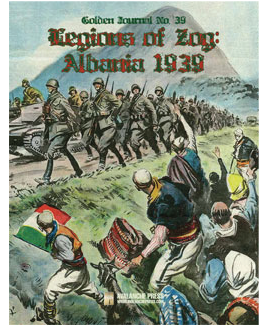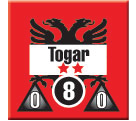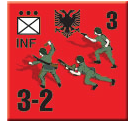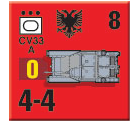| Golden Journal No. 39: Legions of Zog
Publisher’s Preview
by Mike Bennighof, Ph.D.
July 2023
 In September 1928, Albanian President Ahmet Zogu declared his country a constitutional monarchy and himself its monarch as King Zog I. He also named himself Field Marshal of the Royal Albanian Army, and proceeded to rule for the next decade more as a military dictator than as a monarch. In September 1928, Albanian President Ahmet Zogu declared his country a constitutional monarchy and himself its monarch as King Zog I. He also named himself Field Marshal of the Royal Albanian Army, and proceeded to rule for the next decade more as a military dictator than as a monarch.
Despite Zog’s attempts to break free, Italian influence only increased during his reign. The Royal Albanian Army, such as it was, depended on Italian arms, Italian trainers and even Italian officers. Zog survived over 600 blood feuds and at least 55 assassination attempts, but when Queen Geraldine bore him an heir, Benito Mussolini decided to convert Albania from client state to conquest before a dynasty could be established. Italian troops swarmed over the country, and Zog had little means to resist.
As far as I know, no wargame has ever addressed the invasion of Albania at anything more than the most strategic of scales (the Italian player moves one unit into Albania and declares it conquered). Decades ago, my teenaged self actually designed a set of scenarios for a long-forgotten tactical game series; I have no idea why I did that, or what became of them. But I never forgot the doughty fighters of Albania.
Golden Journal No. 39: Legions of Zog is a Panzer Grenadier expansion, based on the five-day Italian invasion of Albania in early April 1939. It includes two dozen new silky-smooth, die cut pieces for the Royal Albanian Army, including the Royal Albanian tank squadron. The maps and the Italian pieces from Conquest of Ethiopia.
 The Albanians are pretty weak to begin with, and made worse by the treachery of their Italian instructors who sabotaged many of their heavy weapons, what few of those they had. The Royal Albanian Gendarmerie (the national police force, with a lot of low-intensity conflict experience dealing with the constant clan feuds and tribal wars outside Albania’s small urban areas) and the Frontier Guard (which likewise had seen its share of small-scale combat) put up a better fight. The Albanians are pretty weak to begin with, and made worse by the treachery of their Italian instructors who sabotaged many of their heavy weapons, what few of those they had. The Royal Albanian Gendarmerie (the national police force, with a lot of low-intensity conflict experience dealing with the constant clan feuds and tribal wars outside Albania’s small urban areas) and the Frontier Guard (which likewise had seen its share of small-scale combat) put up a better fight.
The Italians came with overwhelming force: tens of thousands of troops, hundreds of tanks (very small tanks, but still tanks) and hundreds of airplanes, backed by a powerful fleet. The Albanians had no hope of putting up a fight against that, and no will to put up much of a fight had far fewer Italians hit the beaches. Even so, we have ten scenarios of Italian-Albanian unfriendly interaction, in our usual story-arc format with a pair of battle games to kit them together. Those cover the war pretty thoroughly.
The 24 pieces in Legions of Zog are all Albanian. The Royal Albanian Army had been under Italian influence since its founding in 1928, and the Royal Italian Army had taken over its financing in 1936. The Italians provided instructors, many of whom went well beyond teaching to take direct control of the units to which they were assigned.
 Albanian regular forces consisted of a dozen infantry battalions, including the Royal Guard, plus nine companies of engineers and two motorized infantry companies. Small arms came from Italy, either from Italian producers or stocks of Austro-Hungarian weapons captured at the end of the First World War. Albanian regular forces consisted of a dozen infantry battalions, including the Royal Guard, plus nine companies of engineers and two motorized infantry companies. Small arms came from Italy, either from Italian producers or stocks of Austro-Hungarian weapons captured at the end of the First World War.
In 1935 the Albanians purchased six CV33 Ansaldo-made tankettes; some years earlier they had acquired two Fiat 3000B tanks. The small armored unit depended heavily on its Italian instructors and mechanics; it was not deployed against the invaders and its Italian overseers took custody of the vehicles, which were then taken by the invaders and re-issued to Italian units.
The CV33 had the virtue of a low price, one subsidized by the Italian government in its quest for hard currency, and few other virtues. The Italians would use them with mixed success in the rough terrain of Ethiopia and later during the 1940 invasion of Greece launched from Albanian territory. The handful of tanks might therefore have been of some use to the Albanians, but they had more dire needs for their limited cash reserves.
 Albanian infantry carried a large number of submachine guns compared to most armies of the time, either the Beretta Model 1938 or its predecessor, the Model 1918. The troops also carried the standard Italian infantry rifle of the time, the Carcano M1891, with Austrian-made Mannlicher and Russian-made Moisin-Nagant rifles also found in some units. Albanian infantry carried a large number of submachine guns compared to most armies of the time, either the Beretta Model 1938 or its predecessor, the Model 1918. The troops also carried the standard Italian infantry rifle of the time, the Carcano M1891, with Austrian-made Mannlicher and Russian-made Moisin-Nagant rifles also found in some units.
Albanian regular army infantry units were at cadre strength when the Italians invaded, and never summoned their reservists much less actually brought them into the ranks. Albanian units followed Italian tables of organization, at least on paper, but where the Italian platoon had two rifle-armed assault squads and two support squads with light machine guns, the Albanian platoon had two squads armed with rifles and two with Beretta submachine guns, which did not provide the same effect.
The Albanians did have a heavy machine gun, the Austrian-made Schwarzlose M07, a water-cooled weapon that had equipped the Imperial and Royal Army and soldiered on into World War Two. In Italian service it equipped colonial troops, and so it was issued to the Albanians as well. On paper an Albanian battalion had two platoons of heavy machine guns, and on paper the Royal Albanian Army held enough weapons to have done so, but it’s not clear whether all units actually had their machine guns. In any event they were confiscated after the invasion and returned to the Italian inventory though at least some of them would be wielded by Albanian partisans.
 Albania had limited heavy and medium artillery; two batteries each of Italian-supplied 149mm and 105mm howitzers, none of which were deployed against the invaders. Albanian light artillery consisted of a dozen batteries of 65mm Italian-made mountain guns and six more of Skoda 75mm mountain guns from captured Austrian stocks. During the invasion the most effective Albanian guns were the four 75mm naval pieces removed from patrol boats just before the war and installed as a coastal battery overlooking the port at Durrës. Albania had limited heavy and medium artillery; two batteries each of Italian-supplied 149mm and 105mm howitzers, none of which were deployed against the invaders. Albanian light artillery consisted of a dozen batteries of 65mm Italian-made mountain guns and six more of Skoda 75mm mountain guns from captured Austrian stocks. During the invasion the most effective Albanian guns were the four 75mm naval pieces removed from patrol boats just before the war and installed as a coastal battery overlooking the port at Durrës.
Supporting the regulars were roughly 25,000 tribal militia who in theory could be called to supplement the regular forces. Zog had ordered these men disarmed, and though many had ignored the order the lack of weapons hampered the response to the Italian invasion; only Zog’s Mehti tribe offered much resistance to the invaders. On the other hand, the lack of weapons had also helped keep Zog on the throne until 1939 and greatly reduced clan feuding and local banditry, so a trade-off was involved.
And those are the Legions of Zog.
The Golden Journal is only available to the Gold Club (that’s why we call it the Golden Journal). It’s free when we first offer it, but then it’s $12.99 afterwards. We print enough of them to handle initial demand and a few extras, but once they’re gone we won’t reprint them – there’s just no profit in a company as small as Avalanche Press keeping a $12.99 item perpetually in stock. If you want your Albanians, the time to grab it is now.
Click here to join the Gold Club.
See your Gold Club Insider newsletter for ordering information.
Sign up for our newsletter right here. Your info will never be sold or transferred; we'll just use it to update you on new games and new offers.
Mike Bennighof is president of Avalanche Press and holds a doctorate in history from Emory University. A Fulbright Scholar and NASA Journalist in Space finalist, he has published a great many books, games and articles on historical subjects; people are saying that some of them are actually good.
He lives in Birmingham, Alabama with his wife, three children, and new puppy. He misses his lizard-hunting Iron Dog, Leopold.
Want to keep Daily Content free of third-party ads? You can send us some love (and cash) through this link right here.
|
